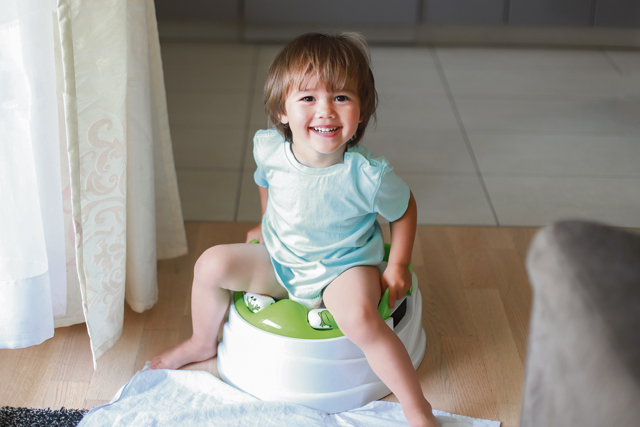
Hey parents! Looking for some poo-poo-pointers? How about some tinkle-tips? Well, you came to the right place! If you are working on the potty training process with your little one, here are some general tips as well as some advice from the real experts — actual parents like you!
Signals that your child is ready for potty training surround the senses. Readiness is sometimes hard to pinpoint, but these signals may indicate it is the right time:
Know it — Your child alerts to needing a diaper change. They “know” it has happened!
Feel it — Your child wakes up from naps with a dry diaper. This means they are able to control their bowel or bladder function. They may also tell you “I’m pooping” as they are sitting in the corner playing with toys. They might also comment on how a wet or dirty diaper feels.
Say it — Your child voices an interest in the potty. They might ask you what you’re doing when you are using the toilet. They might watch a sibling if they are going pee or poop on the potty. They might express an interest in potty books. They might ask for help to try sitting on the potty.
See it — If your child is standing in the bathtub and pees, see if they are watching the pee visually. If it’s warm outside and they are playing outside “al fresco,” are they looking as well? When you empty a poopy diaper into the toilet, involve your child in the process. Say “bye” to the poop and let them flush it away!
Try it — Your child wants to pretend to sit on a potty or helps a baby doll go potty. If you have a small training potty in your living room, this can encourage potty play and they can get on / off independently.
And now, some words of wisdom from parents like you!
When your child has an accident just state what happened “you went pee in your pants/ on the floor. We need to clean that up and next time we will go pee in the potty.” Mistakes are part of learning, just address it and move on with having fun! — Rebecca, mom
Saying “Remember, your pee goes in the potty,” or asking “Where does your pee go?” got a much better response than “You need to try to go pee now.” Also, we have them wear just pants/shorts without underwear for months after potty training begins just to remove the barrier of underwear, which is a lot harder to pull down quickly and far enough.” — Meredith, mom
“A toddler is ready for potty training when they wake up from a nap or sleeping all night and they have a dry diaper. Even if they pee in that diaper seconds after being dry. This helps a parent know the child has the ability for control.” — Judy, mom
“Ask your child if they want to go potty. Then let it go and do your best not to stress over it or try to control it. That’s the hardest part as parents can’t help and compare their child’s potty training ability to other children who potty trained earlier.” — Bob, dad
“I had my kids sit backwards on the potty. This actually helps with bowel and bladder evacuation and lets them face the back, where I had a laminated potty for them to put pictures of pee and poop in and out of the potty picture.” — Elsje, mom
“I always go back to be patient and don’t pressure. There are very few adults who wet or poop themselves! It is a process that takes a different amount of time for each kid and will happen biologically in time” — Vincent, dad
“When kids are really ready to potty train use training underwear instead of “pull-ups” type products so that they can better feel when they have had an accident. I save the pull-ups for when we are riding in the car etc and an accident would be really difficult.
Also there are color changing stickers that can be placed in the bottom of the potty to reveal fun designs when pee (warm water) is applied. Also using a small potty where their feet can touch the ground and knees are above hips, less scary and better for their little pelvic floors!” — Wendy, mom
Author’s profile: Lisa Helenius is a practicing occupational therapist with over 25 years of pediatric experience. She currently is a partner at Growing Up Therapy. See https://growinguptherapy.com for more information.


